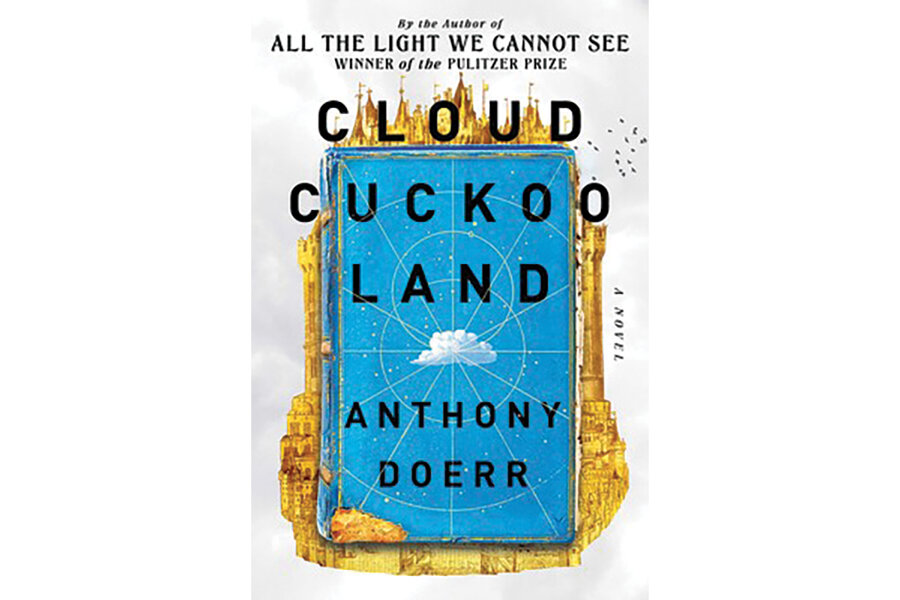Cosmic puzzle-pieces come together in masterly ‘Cloud Cuckoo Land’
Loading...
In this ambitious follow-up to his Pulitzer Prize-winning “All the Light We Cannot See,” Anthony Doerr delivers in a big way. A huge sweep of a story, “Cloud Cuckoo Land” features no fewer than five plotlines and as many key characters contending with big events, challenges, and questions.
In some hands, this could have been a big mess. The good news: Doerr’s creation lifts off quickly, soars, and then, like the various wildfowl wheeling through the story, lands with practiced finesse.
“Cloud Cuckoo Land” may sound to some like a ridiculous title, but readers paging through the book’s opening pages will discover – or be reminded – that the name comes from Aristophanes’ 2,400-year-old play “The Birds.”
Here, “Cloud Cuckoo Land” refers to Doerr’s own made-up myth about a hapless shepherd named Aethon journeying to a utopian city “floated in the heavens.” Purportedly written by Diogenes in the first century, the tale threads through the book; fragments of text from recovered pages introduce each chapter.
In ways both subtle and overt, the myth connects the novel’s chief characters, all of whom face their own journeys in vastly different parts and periods of our world.
There’s Konstance, a 14-year-old aboard a ship called the Argos decades in the future; she shares her quarters with a filament-and-light Artificial Intelligence entity named Sybil. Part of a select group escaping climate-battered Earth for a habitable planet light-years away, Konstance faces the twin challenges of survival and fact-finding after stumbling on a mystery in the ship’s virtual-reality library.
In present-day (although pre-pandemic) Idaho, two very different men cross paths: Zeno Ninis, a Greek American translator in his 80s, and Seymour Stuhlman, a troubled 17-year-old loner who’s most at home in nature.
Elderly Zeno, lonely and buttoned-up, has searched for a sense of home and purpose since being freed from a prison camp in the Korean War. Seymour, who is increasingly overwhelmed by the outside world and devastated by the destruction of a nearby forest that offered soothing shelter, walks a darker road. The local public library – a place of refuge and possibility for both men – becomes their meeting ground, with potentially explosive results.
Finally, Doerr takes readers to 15th-century Constantinople in the months leading up to its siege. Orphaned, inquisitive Anna longs to read and cares for her ailing sister within the city walls. Twelve-year-old oxherd Omeir, a gentle soul conscripted into the Ottoman army with his two mighty oxen, wearily marches south. Anna’s discovery of the “Cloud Cuckoo Land” codex transforms her into both myth-sharer and protector. Omeir has a part to play as well.
Fueled by deep imagination and insistent compassion, Doerr weaves together his storylines with brisk pacing that never feels rushed. His characters struggle, search, and learn, mirroring the travels and trials of Aethon himself.
One of the joys of the novel is its vivid, energetic language. Birds and more birds – owls, terns, osprey, grouse – fly off the page. Embroiderers conjure “a nightingale from thread and patience.” A leering merchant hunches like a vulture. Letters are packed onto a parchment “like the tracks of a hundred shorebirds.”
Aethon’s narrative plays two important roles in the book. First, the myth is an idea – an instructive tale about the hunt for someplace better: an aerial nirvana. Second, the myth is a form – first tablets, then parchment, then a codex, and later pixels – in need of translation and care.
With its emphasis on the importance of sharing and preserving stories, “Cloud Cuckoo Land” is, ultimately, an ode to libraries. These repositories and their keepers, Doerr asserts, play an essential role in introducing humanity to ideas and helping ensure those ideas endure.
Whether battered by war, climate disaster, or alienation, Konstance, Zeno, Seymour, Anna, and Omeir all strive for nostos, or “homecoming, a safe arrival.” And although their homecomings look very different, each prevails.
Writing in the midst of pandemic and lockdown, Doerr, in the words of Aristophanes, has successfully created “something big, smacking of the clouds.”








